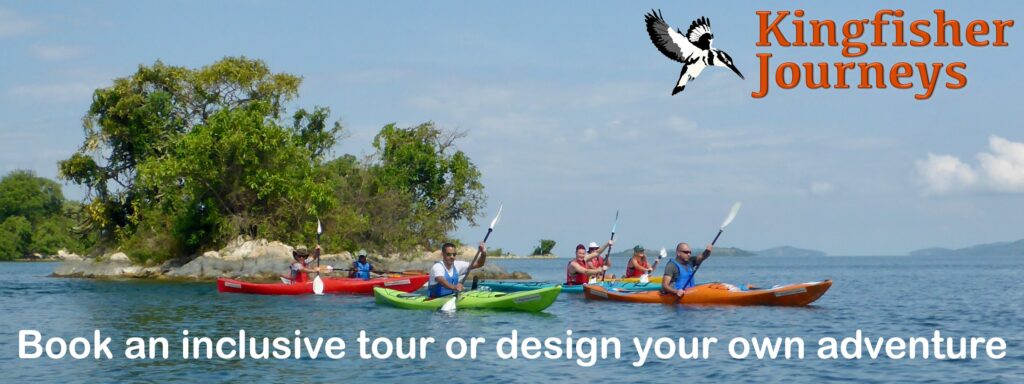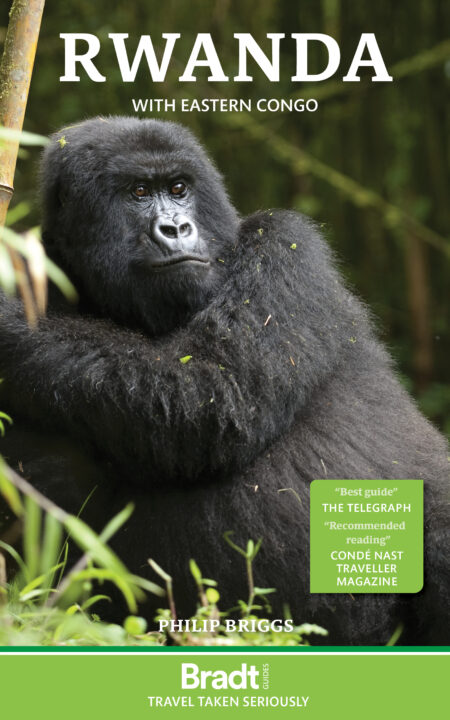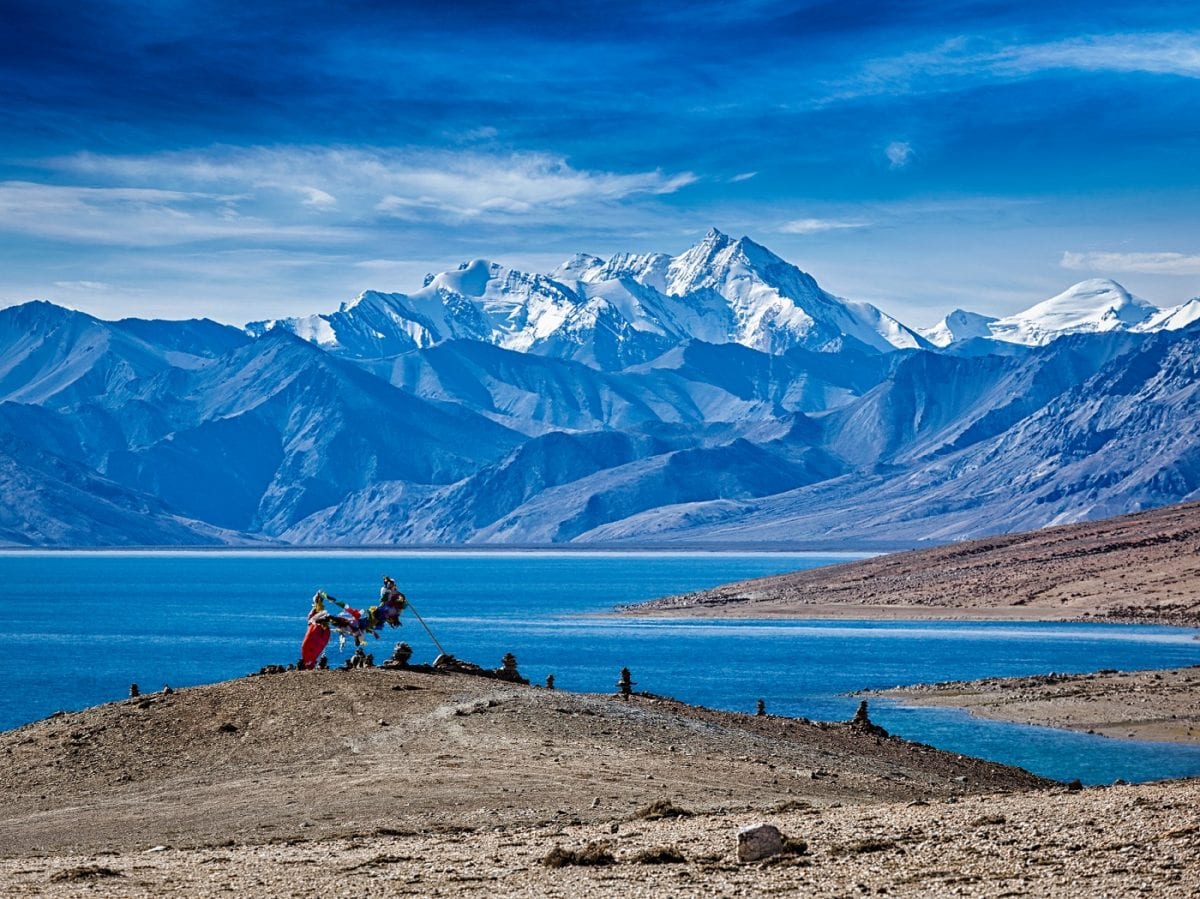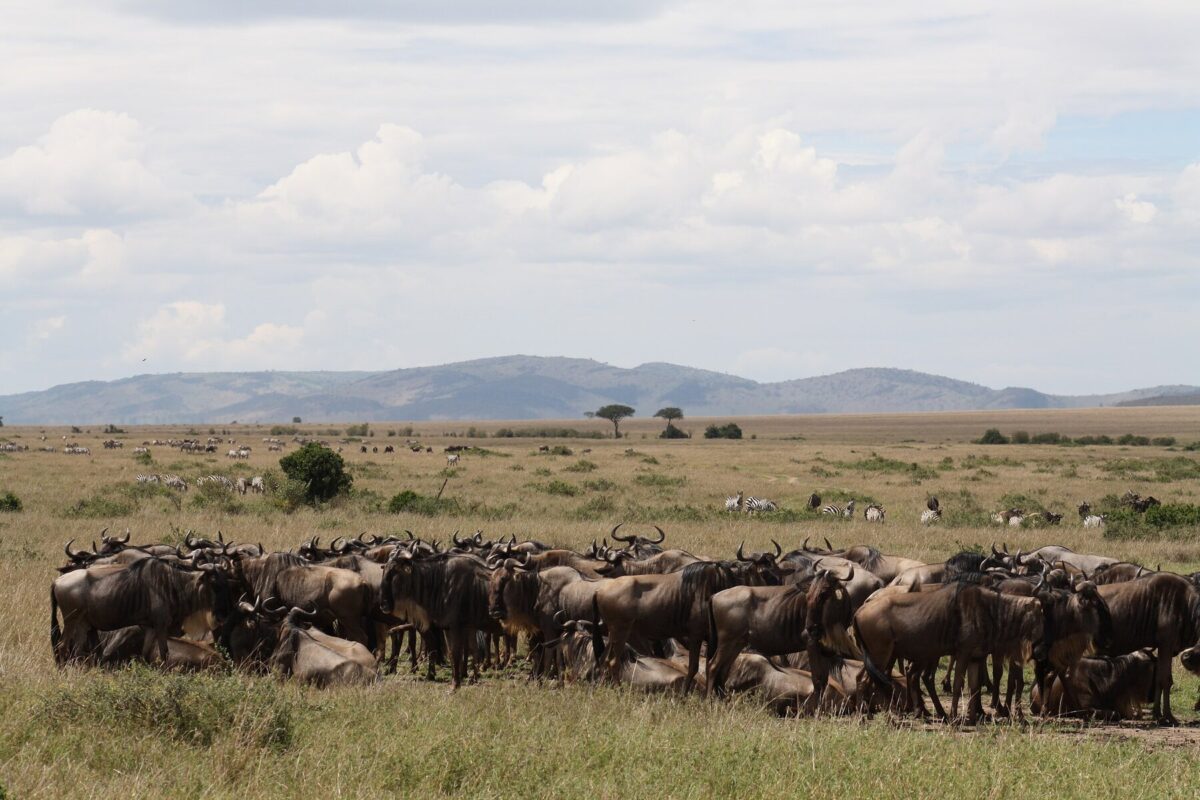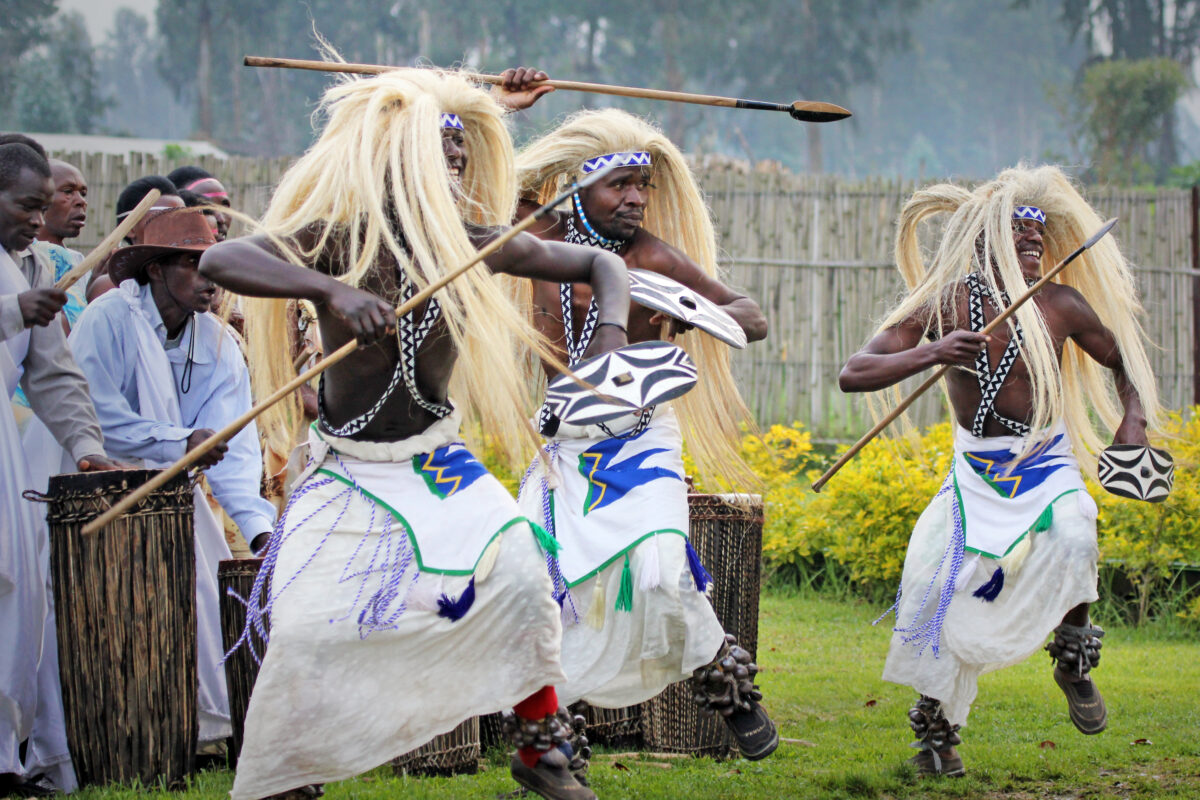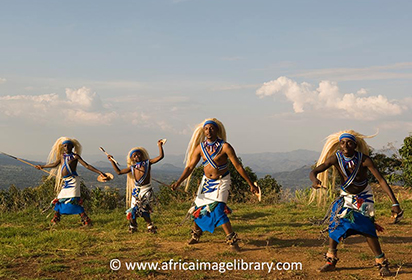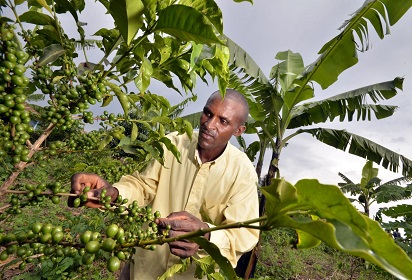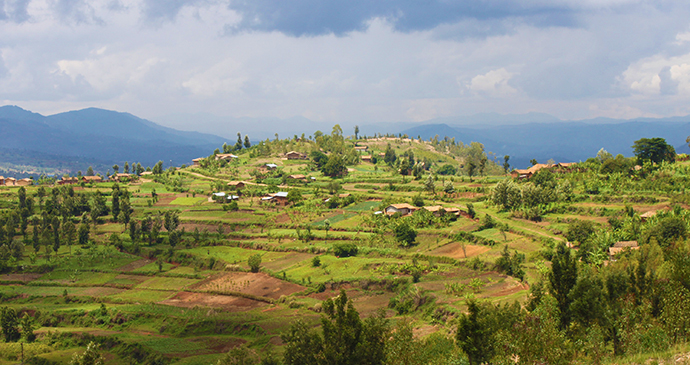If you’ve ever dreamed of tracking gorillas on the same misty slopes once trodden by Dian Fossey or Sigourney Weaver, go to Rwanda. And while you’re about it, don’t forget that there is much to see there besides gorillas.
Philip Briggs, author of Rwanda: the Bradt Guide
Rwanda ranks among the world’s most exciting emergent ecotourism destinations. Few would have expected it 25 years ago, when a long-simmering civil war erupted into a tragic genocide in which up to a million people died. But two decades of subsequent political stability have seen Rwanda emerge as one of the most economically vibrant and socially progressive countries in Africa.
Rwanda’s top draw is of course the mountain gorillas that inhabit the misty slope of the Virunga Volcanoes along its northern border. Arguably the most exciting and moving wildlife encounter you’ll ever experience, it starts with a tense ascent through fertile volcanic slopes dense with cultivation, into a hushed montane forest of impenetrable bamboo skyscrapers, until finally you come face to face with one of these extraordinary creatures. It’s a truly awesome experience – inspirational, emotional, and profoundly satisfying.
Rwanda is the world’s premier gorilla-tracking destination. But there is much to see there besides gorillas. The mountain-ringed inland sea that is Lake Kivu; the immense Nyungwe Forest National Park with its chimpanzees, monkeys and rare birds; the wild savannah of Akagera National Park – and, perhaps above all, the endless succession of steep cultivated mountains that have justifiably earned Rwanda the soubriquets ‘Land of a Thousand Hills’ and ‘The Switzerland of Africa’. It’s a wonderful place to visit.
Rwanda is on our list of 2023 Exceptional Trips! Read the full list here.
For more information, check out our guide to Rwanda:
Food and drink in Rwanda
Food
Kigali boasts an impressive and growing range of restaurants representing international cuisines such as Indian, Italian, Chinese and French. In most other towns, a couple of hotels or restaurants serve uncomplicated Western meals – chicken, fish or steak with chips or rice. Possibly as a result of the Belgian influence, restaurant standards seem to be far higher than in most East African countries, and Rwandan chips are among the best on the continent. Servings tend to be dauntingly large, and prices very reasonable. Buffet or self-service meals are also on offer, often at very inexpensive rates. Smarter restaurants, especially in Kigali, may be closed or take a while to rustle up food outside of normal mealtimes.
Wherever you travel, local restaurants serve Rwandan favourites such as goat kebabs (brochettes), grilled or fried tilapia (a type of lake fish), bean or meat stews. These are normally eaten with one of a few staples: ugali (a stiff porridge made with maize meal), matoke (stewed cooking banana/plantain), chapatti (flat bread), and boiled potatoes (as in Uganda, these are somewhat mysteriously referred to as Irish potatoes) – not to mention rice and the ubiquitous chips.
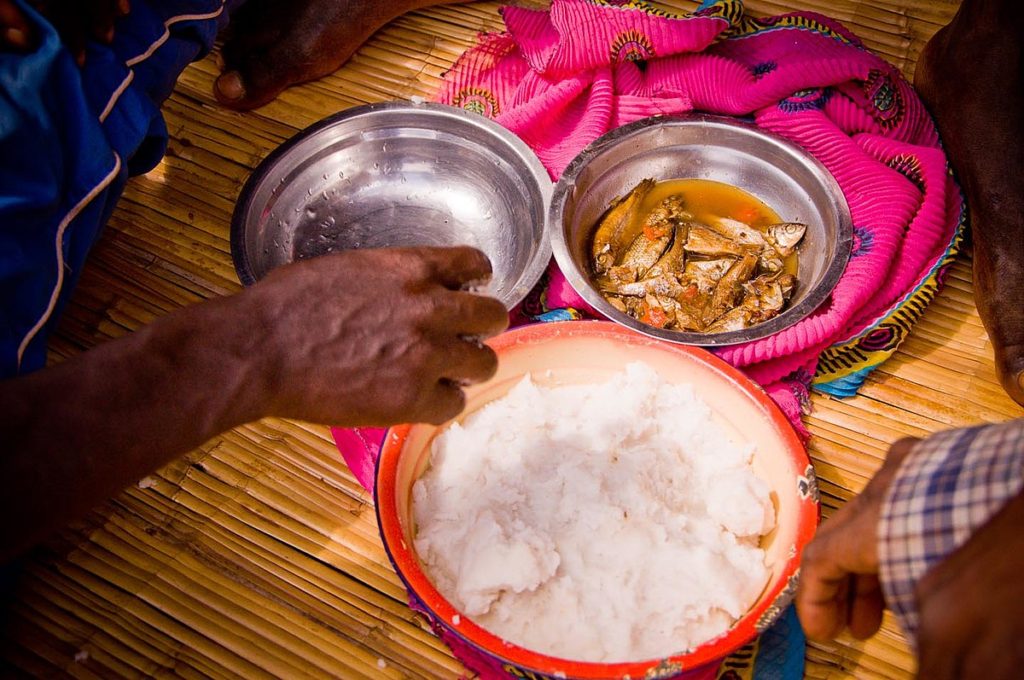
Unless you have an insatiable appetite for greasy omelettes or stale mandazi (deep-fried dough balls not dissimilar to doughnuts), breakfast outside of Kigali (where very fine pastries, croissants and coffees are to be had) can be a problematic meal, though this too is changing with the opening of good cafés in cities around the country.
One area in which Rwanda is definitely influenced more by its anglophone neighbours than by its former coloniser is baking: in common with the rest of East Africa, the bread is almost always sweetish and goes stale quickly. In such cases a bunch of bananas, supplemented by other fresh fruit, is about the best breakfast option: cheap, nutritious and filling.
The alternative to eating at restaurants is to put together your own meals at markets and supermarkets. The variety of foodstuffs you can buy varies from season to season and from town to town, but in most major centres you can rely on finding a supermarket that stocks frozen meat, a few tinned goods, biscuits, pasta, rice and chocolate bars. Fruit and vegetables are best bought at markets, where they are very cheap. Potatoes, sweet potatoes, onions, tomatoes, bananas, sugar cane, avocados, paw-paws, mangoes, coconuts, oranges and pineapples are seasonally available in most towns. For hikers, about the only dehydrated meals available are packet soups.
Drinks
Brand-name soft drinks such as Pepsi, Coca-Cola and Fanta are widely available, and cheap by international standards. Tap water is debatably safe to drink in Kigali, although the smell of chlorine may put you off; bottled mineral water is widely available if you sensibly prefer not to take the risk. Locally bottled fruit juice (passion fruit, orange, pineapple…) isn’t bad and comes in concentrated versions too.
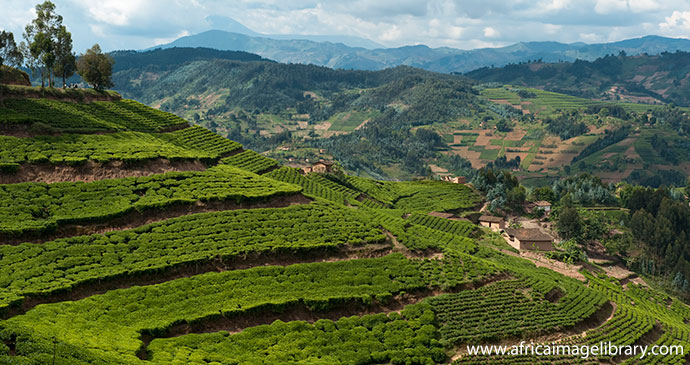
The most widely drunk hot beverage is tea (icyayi in Kinyarwanda, sometimes also referred to by the Swahili name chai). In rural areas, the ingredients are often boiled together in a pot: a sticky, sweet, milky concoction that is sometime referred to as African tea, and that definitely falls into the category of acquired tastes. Most Westernised restaurants serve tea as we know it, but if you want to be certain, specify that you want black tea. The milk served separately with it is almost always powdered, but of a type that dissolves well and doesn’t taste too bad.
Coffee is one of Rwanda’s main cash crops, but you’d hardly know it judging by the insipid slop that passes for coffee in some restaurants and hotels – though this may soon be a thing of the past as something akin to café culture has taken hold in Kigali and seems to be spreading throughout the country.
The most popular alcoholic drink is beer, brewed locally near Rubavu. The cheaper of the two local brands is Primus, which comes in 700ml bottles. The most popular alternative is Mutzig, which tastes little different, costs about 30% more and comes in 700ml or 350ml bottles. Skol and Gatanu are also ubiquitous and rather generic lagers, while fans of darker beers will want to give Turbo King or Virunga Mist a try. South African and French wines are sold at outrageously inflated prices in a few upmarket bars and restaurants. Far more sensibly priced are the boxes of Spanish or Italian wine sold in some supermarkets. If you want to check out your capacity for locally brewed banana wine (also called urwagwa) before ordering it with a meal, most supermarkets and some small grocers/snack bars have bottles on sale. It comes in many varieties – some have honey added. There’s also a banana liqueur.
As for the harder stuff, waragi, a millet-based clear alcohol from Uganda, is available everywhere; either knock it back neat or mix it as you would gin. (In its undistilled form it could strip away a few layers of skin!) The illegal Rwandan firewater, kanyanga, is also available widely: treat with care.
Health and safety in Rwanda
Health
Rwanda itself isn’t a particularly unhealthy country for tourists and you’ll never be far from some kind of medical help. The main towns have hospitals (for anything serious you’ll be more comfortable in Kigali) and all towns of any size have a pharmacy, although the range of medicines on sale may be limited. In Kigali, the pharmacy in Boulevard de la Révolution is open 24 hours.
Away from Kigali, district hospitals and health centres are spread countrywide. A health centre generally has around five nurses, supported by a doctor and community health workers. In rural areas traditional medicine is also widely used. The growing private sector has more than 310 clinics and dispensaries. The incidence of HIV/AIDS is hard to estimate accurately but seems at last to be falling, thanks to preventive measures and the wider availability of antiretroviral drugs.
The most serious health threat to travellers in Rwanda is malaria. Akagera National Park and other low-lying parts of the east qualify as high risk malarial areas, especially in the rainy season. The risk exists but is far lower in highland areas such as Kigali, Butare, Nyungwe National Park, the Virunga Mountains and foothills, and the Lake Kivu region. Nevertheless, all visitors to Rwanda should take preventative measures against malaria, and be alert to potential symptoms both during their trip and after they return home.
Other less common but genuine health threats include the usual array of sanitation-related diseases – cholera, giardia, dysentery, typhoid etc – associated with the tropics (though these seem to affect visitors to Africa less than they do travellers in Asia), and bilharzia, which can only be caught by swimming in freshwater habitats inhabited by the snail that carries the disease.
Preparations to ensure a healthy trip to Rwanda require checks on your immunisation status: it is wise to be up to date on tetanus, polio and diphtheria (now given as an all-in-one vaccine, Revaxis, that lasts for ten years), and hepatitis A. Immunisations against meningococcus and rabies may also be recommended. Proof of vaccination against yellow fever is needed for entry into Rwanda for all travellers over one year of age, regardless of where you are coming from. Immunisation against cholera may also be recommended for Rwanda.
If you do get ill in Rwanda, bear in mind that the most likely culprit – as in most parts of the world – will be the common cold, flu or travellers’ diarrhoea, none of which normally constitute a serious health threat. However, travellers with overt cold- or flu-like symptoms might not be allowed to track gorillas or chimpanzees, both of which are susceptible to infectious airborne human diseases and may lack our resistance.
Safety
So far as tourists need be concerned, Rwanda is among the most crime-free of African countries. Kigali is a very safe city, even at night, though it would probably be courting trouble to stumble around dark alleys with all your valuables on your person. Be aware, too, that this sort of thing can change very quickly: all too often, as tourism volumes increase, so too does opportunistic and petty crime.
The following security hints are applicable anywhere in Africa:
- Most casual thieves operate in busy markets and bus stations. Keep a close watch on your possessions in such places, and avoid having valuables or large amounts of money loose in your daypack or pocket.
- Keep all your valuables and the bulk of your money in a hidden money belt. Never show this money belt in public. Keep any spare cash you need elsewhere on your person – a button-up pocket on the front of the shirt is a good place as money cannot be snatched from it without the thief coming into your view. It is also advisable to keep a small amount of hard currency (ideally cash) hidden in your luggage in case you lose your money belt.
- Where the choice exists between carrying valuables on your person or leaving them in a locked room I would favour the latter option (thefts from locked hotel rooms are relatively rare in Africa). Obviously you should use your judgement on this and be sure the room is absolutely secure. Bear in mind that some travellers’ cheque companies will not refund cheques which were stolen from a room.
- Leave any jewellery of financial or sentimental value at home.
Travel and visas in Rwanda
Visas
Check well in advance that you have a valid passport, and that it won’t expire within six months of the date you intend to leave Rwanda. Should your passport be lost or stolen, it will generally be easier to get a replacement if you travel with a photocopy of the important pages.
As of 1 January 2018, citizens of all countries can purchase a 30-day, single-entry visitor visa on arrival for US$30 at the airport or any land border with no advance application. Multiple entry and other classes of visa still have to be applied for in advance at a Rwandan mission abroad.
For its part, Rwanda requires travellers from any country who intend to use the EAC visa to apply at either a Rwandan embassy abroad or online before arriving. If your online application is successful, you’ll get a confirmation number via email – bring a printed copy of this document to any port of entry, where the visa will be issued. Payment can be made either online when completing the application or in cash upon arrival. More information is available at migration.gov.rw, and all applications and payments are now made through the new one-stop government services portal at irembo.gov.rw. Foreigners with a long-term work/residency permit in Rwanda, Uganda, or Kenya are entitled to visa-free travel between the three countries.
Getting there and away
By air
The rapidly expanding national airline RwandAir now flies between Kigali and London Gatwick via Brussels three times a week, as well as regularly connecting to Mumbai, Dubai and Guangzhou. Their secondary hub is in Cotonou (Benin), from where they connect to a variety of West African capitals.
Other operators that fly directly to Kigali include Kenya Airways , Brussels Airlines, KLM, Ethiopian Airways, South African Airways, Turkish Airlines and Qatar Airways. All of these carriers operate a good network of intra- and intercontinental flights – travellers coming from Australasia will do best to aim for Johannesburg, Doha, Dubai or Nairobi, while those from Europe and the Americas are best off flying via Brussels, Istanbul or Addis Ababa.
Overland
Four countries border Rwanda: Burundi to the south, the Democratic Republic of the Congo (DRC) to the west, Uganda to the north and Tanzania to the east. Assuming peaceful conditions, frontier formalities aren’t too much of a hassle – but nor are they standardised. Smaller crossings are typically open from 06.00 to 18.00, but Kagitumba and Cyanika (both to Uganda) stay open until 20.00, and larger ones like the Grande Barrière/corniche in Gisenyi (to Goma/DRC), Rusizi (to Bukavu/DRC), Rusumo (to Tanzania), and Nemba (to Burundi) stay open until 22.00. The Gatuna border post with Uganda now operates 24 hours a day.
Owing to the political crisis in Burundi and simmering tensions between the two countries, public transport hasn’t been allowed to cross the border since 2016 and all trips to/from Burundi currently (as of 2018) require a change of vehicle at the border.
Despite the ongoing unrest in the DRC, it is normally safe to travel in the immediate Rwandan border area, which includes the Congolese border towns of Goma and Bukavu and their neighbouring national parks, Virunga and Kahuzi- Biega. Still, you’re strongly advised to check the current situation first as this can change.
Crossing to and from Uganda is simple. Direct buses and minibus-taxis connect Kampala and Kigali, taking around 12 hours if you do the trip in one leg. The best operator along this route is probably Modern Coast, who connect Kigali to several destinations in Kenya via Kampala.
Crossing between Rwanda and Tanzania is something of a slog, due to the poor (but improving) state of roads and lack of large towns in northwest Tanzania. The Rusumo border post lies about 160km from Kigali, roughly a 3-hour trip by minibus-taxi, with the possibility of staying the night en route at the town of Ngoma, 60km from the border, or at the surprisingly pleasant accommodation on offer in Rusumo itself, on the Rwandan side of the river.
Getting around
Self-drive
Several travel agencies in Kigali rent out saloons and 4x4s, with or without drivers. Rates vary according to whether you’ll be driving outside Kigali, and whether fuel is included. If you rent a self-drive vehicle, be aware that Rwanda follows the continental and American custom of driving on the right side of the road. Check the vehicle over carefully and ask to take it for a test drive. Even if you’re not knowledgeable about the working of engines, a few minutes on the road should be sufficient to establish whether it has any seriously disturbing creaks, rattles or other noises.
Roads are generally good but there are still some pot-holed sections along most routes which, together with the winding terrain and the tendency for Rwandans to drive at breakneck speeds and overtake on sharp or blind corners, necessitate a more cautious approach than one might take at home.
Boat and rail
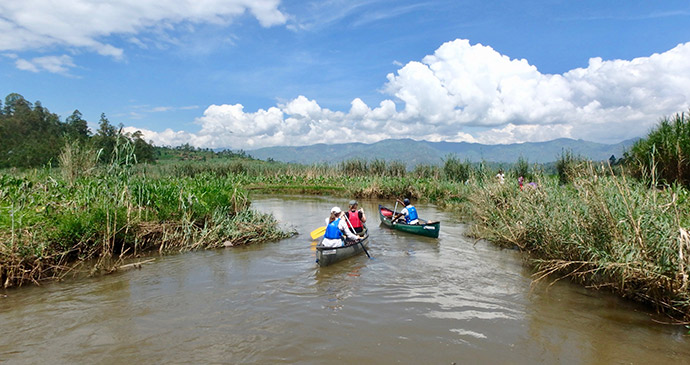
There are no rail services in Rwanda, although a rail link with Tanzania has been under discussion for some time and Rwanda one day also hopes to connect to the standard-gauge railway recently completed between Mombasa and Nairobi.
Public ferry services on Lake Kivu, operated by the COTRALAKI Cooperative, restarted in 2014 and ply the waters between Rusizi/Cyangugu, Karongi/Kibuye, and Rubavu/Gisenyi twice a week. In the DRC, there are several boats connecting Goma and Bukavu, including the Ihusi Express, a reliable, fast ferry service with two daily departures, which also stops on Idjwi Island.
It’s also possible to rent local dugouts for short excursions on the lake, and motor boats are available for hire at Karongi, Rusizi and Rubavu. Small boats can be used to get around the smaller lakes, such as Burera, Ruhondo or Muhazi, by making an informal arrangement with the boat owner.
Public transport
The main mode of road transport is shared mini-/midibuses; these connect all major centres (and most minor ones) and leave from each town’s dedicated bus station (gare taxi/minibus). The larger routes are for the most part all covered by private companies operating scheduled midibuses (Toyota Coasters or something similar), which hold up to 32 passengers and depart according to a fixed schedule. Heading out into the smaller towns and villages, smaller white-and green minibuses operated by the Rwanda Federation of Transport Cooperatives (RFTC) take over, which are significantly less comfortable and only depart when full. Also worth mentioning is the government-backed Ritco, which has replaced the now-defunct ONTRACOM and runs regular and reliable coach buses to major destinations throughout the country.
Two-wheeled taxis
Just about everywhere in Rwanda you’ll find ‘taxis’ in the form of motorbikes (motos), or sometimes standard bicycles as well. They’re handy for short distances – but be aware that your travel insurance may not cover you for accidents when on either of them. Agree a price beforehand, and check with a passer-by if it seems excessive.
When to visit Rwanda
Rwanda can be visited at any time of year. The long dry season, June to September, is the best time for tracking gorillas in the Volcanoes National Park and for hiking in Nyungwe Forest, since the ground should be dry underfoot and the odds of being drenched are minimal. This should not be a major consideration for any reasonably fit and agile travellers unless they are planning to hike to Virunga peaks such as Bisoke or Karisimbi, in which case the rainy season is best avoided. The dry season is also the best time to travel on dirt roads, and when the risk of malaria is lowest.
There are two annual rainy seasons. The big rains run from mid-February to early June, and the small rains from mid-September to mid-December. Rainfall, especially over the mountains, can be heavy during these two periods – particularly from March to May, although it is still perfectly feasible to travel at these times of year, and, for those visiting at short notice, it is far easier to obtain a gorilla permit at the last minute.
As for the two dry seasons, the major one lasts from June to September and the shorter from December to February. However, the climate is not uniform throughout the country: it is generally dryer in the east than in the west and north. On occasion, the volcanoes of the north may be capped by snow, and evenings in Kigali can call for a sweater – as do days anywhere in the highlands should you happen to hit a cold snap! Nevertheless, every season is good for swimming and tanning on the banks of Lake Kivu.
An advantage of travelling during the rainy season is that the scenery is greener, and the sky less hazy (at least when it isn’t overcast), a factor that will be of particular significance to photographers. The wet season is also the best time to track chimps in Nyungwe (in the dry season they may wander further off in search of scarce food), while the months of November to March will hold the greatest appeal for birders, as resident birds are supplemented by flocks of Palaearctic migrants.
If you want to view and compare sample itineraries, please see the Rwanda gorilla trekking and safari tours section on SafariBookings. This comparison website lists tours offered by both local and international tour operators.
What to see and do in Rwanda
National Museum of Rwanda
If you’re in Huye, do allow time to visit this beautifully presented collection of exhibits on Rwandan history and culture. As you approach Huye on the Kigali road, you’ll see its colourful fence on the right. Opened in 1988, and presented to Rwanda as a gift from Belgium’s King Baudouin I, it is situated on more than 20ha of land containing indigenous vegetation and a traditional craft training centre as well as the main 2,500m² museum building, whose seven spacious rooms illustrate the country and its people from earliest times until the present day. At the reception desk, various English-language pamphlets and books are on sale, and most displays are labelled in English as well as Kinyarwanda.
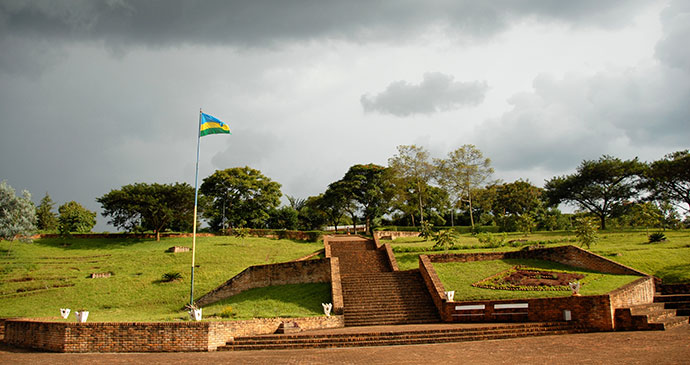
Room 1 (the entrance hall) has space for temporary displays as well as numerous shelves of traditional handicrafts for sale. Room 2 presents a comprehensive view of Rwanda’s geological and geographical background and the development of its terrain and population. In Room 3 the occupations of its early inhabitants (hunter-gathering, farming and stock-raising) are illustrated, together with the later development of tools and methods of transport. The social importance of cattle is explained and there are even detailed instructions for the brewing of traditional banana beer.
Room 4 displays a variety of handicrafts and the making of traditional household items: pottery, mats, baskets, leatherwork and the wooden shields of the Intore dancers. Room 5 illustrates traditional styles and methods of architecture – and a full-scale royal hut has been reconstructed. In Room 6 traditional games and sports are displayed and more space is given to the costumes and equipment of the Intore dancers. Finally, Room 7 contains exhibits relating to traditional customs and beliefs, history, culture, poetry, oral tradition and the supernatural.
Lake Kivu
Running along the Congolese border for 90km, the 2,370km² Lake Kivu is one of a string of ‘inland seas’ that submerge much of the Albertine Rift floor as it runs southward from the Sudan to Zambia. It is very a beautiful lake, hemmed in by steeply terraced escarpments containing several peaks of 2,800m or higher, including the smoking outline of volcanic Nyiragongo in the far north, and it has long served as a popular weekend getaway for residents of this otherwise landlocked country.
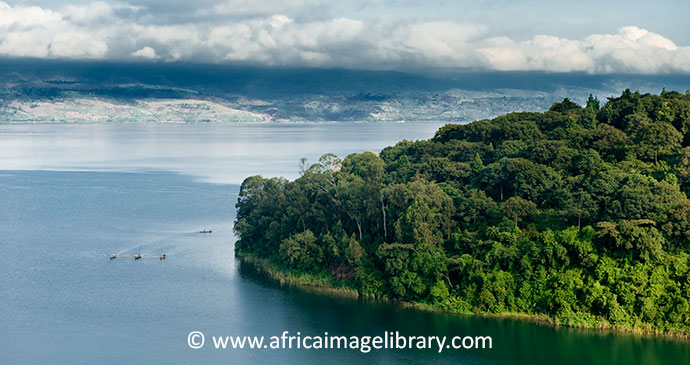
Kivu has a smaller surface area than the two most expansive Albertine Rift lakes, the more southerly Tanganyika and more northerly Albert. Nevertheless, a maximum depth of 480m and total water content of 333km3 places it among the world’s 20 deepest and 20 most voluminous freshwater bodies. In addition, the 285km² Idjwi Island, which falls entirely within Congolese territory, is the second largest inland island in Africa and tenth largest in the world.
Kivu supports an impoverished fauna by comparison with other large Rift Valley lakes, as a result of an unusually high level of volcanic activity. The geological record suggests that the release of methane trapped below the lake’s surface has resulted in regular mass extinctions every few thousand years. As a result, fewer than 30 fish species are known from the lake and, while this does include 16 endemics, it pales by comparison with the many hundreds of species recorded from Lakes Victoria and Tanganyika.
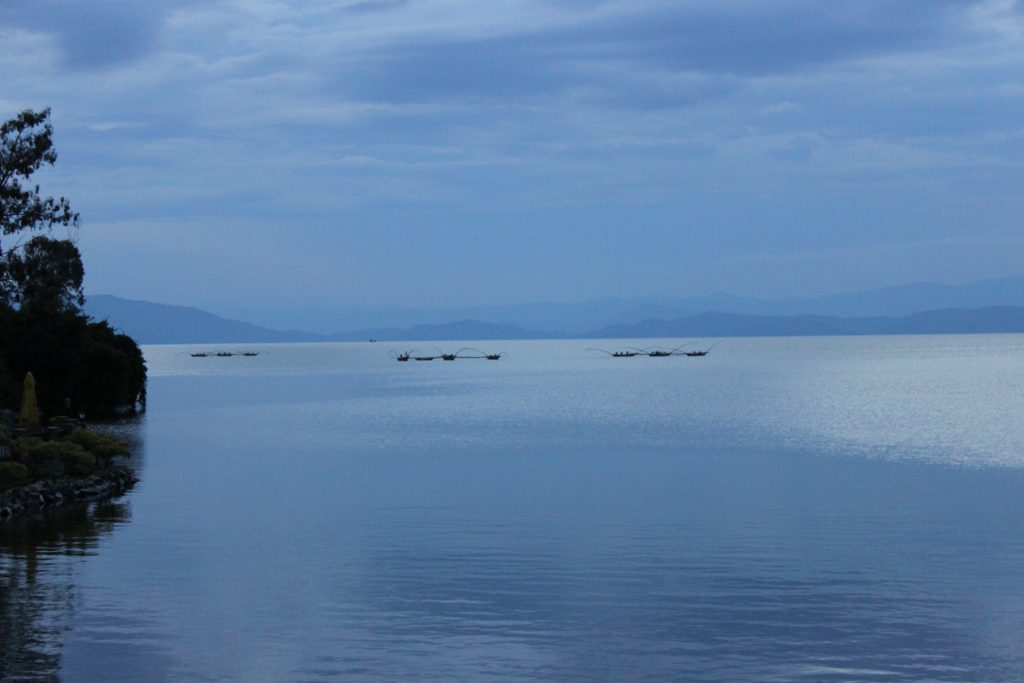
High methane levels probably also explain the complete absence of hippo and croc, and are also cited by those who claim that the lake has no Bilharzia (a claim contradicted by certain anecdotal reports from expatriates). Kivu’s attractively irregular shoreline, with its verdant slopes and sandy beaches, is served by three main resort towns. The most northerly of these, Rubavu/Gisenyi, has the best tourist facilities, partly because of its proximity to Volcanoes National Park.
Karongi/Kibuye, further south and with the advantage of being far closer to Kigali, also has a few decent lakeshore hotels. At the southern end of the lake, overlooking the exit point of the Rusizi River, Rusizi/Cyangugu can easily be visited in conjunction with Nyungwe National Park and Huye/Butare, and has recently gained its first hotel meeting international standards.
Kigali Genocide Memorial
This dignified memorial has been constructed in Gisozi, the burial site of over 250,000 people killed in a three-month period during Rwanda’s 1994 genocide. It opened fully for the tenth anniversary of the genocide in April 2004.
Importantly, the memorial centre is not just a mass grave and exhibition. At the request of Kigali City Council, it was created – and is managed today – by the UK-based Aegis Trust (a non-sectarian, non-governmental genocide prevention organisation). Aegis operates a Rebuilding Lives programme to help widows and orphans of the genocide, and a peace-building education programme (hosted at the memorial) educating a new generation about the dangers of prejudice and helping to establish trust between the children of survivors and perpetrators.
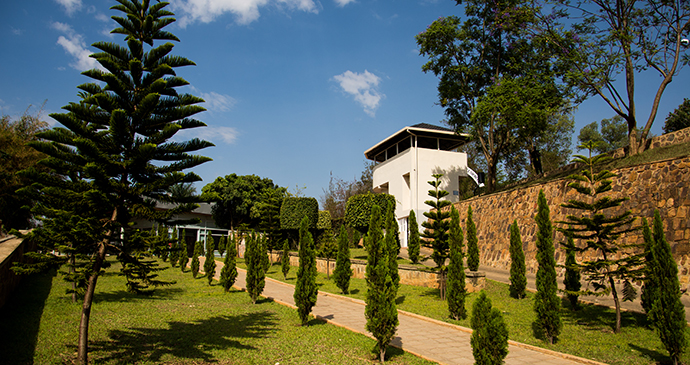
The memorial centre is now also home to the Genocide Archive of Rwanda, which is open to the public. The purpose of the archive centre is to illuminate genocidal ideologies and their impact. The archive collection includes photographs, official documents and geographical data.
Entry is free but contributions are very much welcomed because the centre relies on proceeds for the upkeep of the mass graves and the exhibitions. Recently it has developed an audio tour which is currently available in English, French, Dutch and German, Italian and Spanish. It is comprehensive, and is particularly helpful for understanding the outside exhibits such as the gardens and mass graves. There is also a bookshop that sells a good selection of films, music and books on the theme of genocide and prevention.
Kigali
The low-key but attractive Rwandan capital city of Kigali stands in the centre of the country, where it straggles over several hills and valleys, spanning altitudes of around 1,300m to 1,600m. The city was founded in 1907 at a location chosen by Dr Richard Kandt, who built an administrative residence close to the presentday Gakinjiro Market. Two years later, 20 further houses were built (one of which has been restored as a history museum) on the eastern slopes of Nyarugenge Hill, which now forms the commercial city centre.
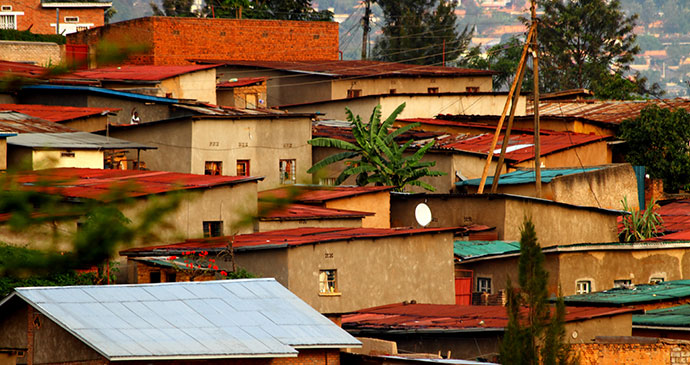
Kigali remained a small and isolated colonial outpost until 1916, when Belgium ousted Ruanda-Urundi’s German colonisers. Under Belgian rule, Kigali retained an important administrative role, but urban growth was very slow and confined mainly to Nyarugenge. Indeed, when Rwanda gained independence in 1962, the population of Kigali stood at no more than 6,000. When Ruanda-Urundi (the capital of which was Usumbura, now named Bujumbura) split into Rwanda and Burundi, the strongest contender to become Rwanda’s new capital seemed to be Butare (now known as Huye), which had been the more important administrative centre during colonisation.
However, Kigali’s central position and good road links to the rest of the country won out. As a result, while Huye has avoided capital-city brashness and remains relatively calm, Kigali has grown dramatically, with the 2012 census returning the city’s first-ever million-plus population count of 1,132,686 people. The commercial city centre is still on Nyarugenge Hill, while the government and administrative quarter is further east on Kacyiru Hill. Between and around these elevated twin centres, empty spaces on the hillsides are filling with new housing, and pollution in the valleys (from the increasing volume of traffic) could soon be a problem.
The centre of Kigali is bustling, colourful and noisy, but impressively clean and safe (indeed, in 2008, Kigali was effectively pronounced the cleanest city on the continent, when it became the fifth the Habitat Scroll of Honour award, an annual award launched by the UN Human Settlements Programme in 1989). However, it is undergoing rapid development and change, with shiny new shopping malls, hotels and office buildings springing up all over the city; most recently, the construction of a huge new US$12.9 million city hall, and the even larger, US$300 million Kigali Convention Centre, replete with its own five-star hotel, office park and cavernous conference facilities, which was inaugurated in 2016. And while this is all well and good for Kigali’s increasingly striking skyline, it remains to be seen if the city’s green credentials survive all this development.
Akagera National Park
Named after the river that runs along its eastern boundary, Akagera National Park is Rwanda’s counterpart to the famous savannah reserves of Kenya, Tanzania and the like. In contrast to the rest of the country, it is located in a relatively warm and low-lying area of undulating plains supporting a cover of dense, broadleafed woodland interspersed with lighter acacia woodland and patches of rolling grassland studded evocatively with stands of the superficially cactus-like Euphorbia candelabra shrub. To the west of the plains lies a chain of low mountains, reaching elevations of between 1,600m and 1,800m. The eastern part of the park supports an extensive wetland: a complex of a dozen lakes linked by extensive papyrus swamps and winding water channels fed by the meandering Akagera (sometimes called Kagera) River.
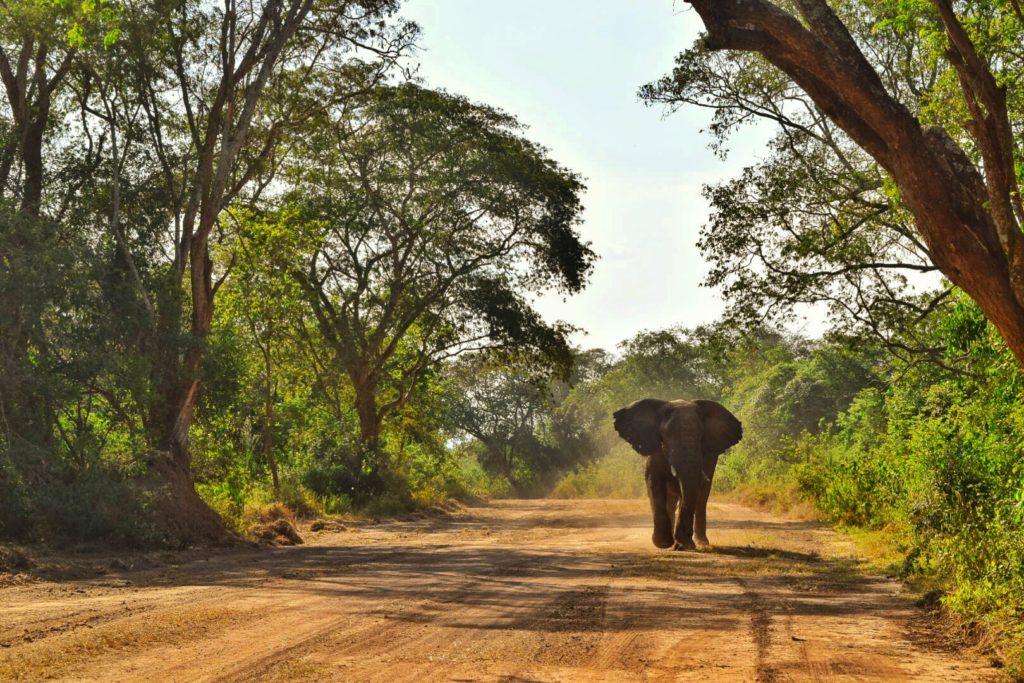
In terms of game-viewing, it would be misleading to compare Akagera to East Africa’s finest savannah reserves. The northern and western portions of the original 2,500km² park were degazetted in 1997 (along with the adjoining 300km² Mutara Wildlife Reserve) to accommodate returned refugees, reducing the protected area to 1,085km². Though largely under control now, poaching has also impacted negatively on wildlife populations, and those lakes that remain within the national park were until not so long ago often used to water domestic cattle – indeed, in the early 2000s, long-horned Ankole cows were the most commonly seen large mammal in Akagera.
However, since the 2010 formation of the Akagera Management Company (AMC) under the joint management of the RDB and the non-profit African Parks Network (APN), the park has seen a dramatic resurgence. Since then, a number of new roads have been constructed in the park, a fabulous upmarket tented camp opened at the end of 2012, and the 120km western boundary fence was completed in 2013. Most excitingly of all, perhaps, is the ongoing programme of reintroductions, which has now seen both lions and rhinos once again taking up residence in Akagera for the first time in more than a decade.
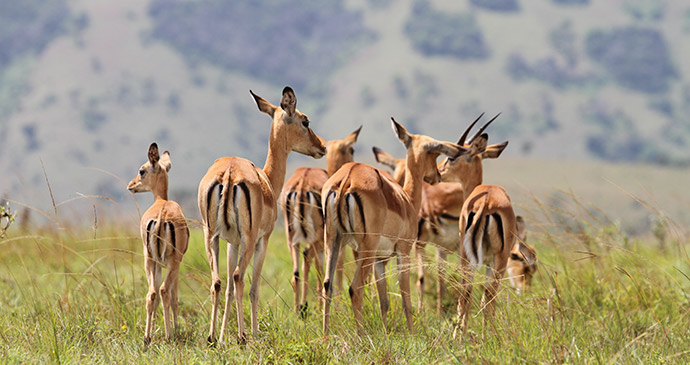
More so than it has been at any time in recent decades, Akagera today is emphatically worth visiting. For one thing, it ranks among the most scenic of Africa’s savannah reserves, with its sumptuous forest-fringed lakes, tall mountains and constantly changing vegetation. On top of that, the birdlife is quite phenomenal – for specialist birders, the checklist of almost 500 species includes several good rarities, while for first-time African visitors, it’s a great place to see eagles and other large raptors along with some truly impressive concentrations of water-associated birds.
Akagera also still retains a genuinely off-the-beaten-track character: this is one African game reserve where you can still drive for hours without passing another vehicle, never knowing what wildlife encounter might lie around the next corner. And contrary to some reports, there is plenty of wildlife around, with the likes of zebra, giraffe, hippo, baboon, warthog and half-a-dozen antelope species all reasonably visible, and less skittish than one might expect. In addition, the lakes support some of the highest concentrations of hippo you’ll find anywhere in Africa, as well as numerous large crocodiles.
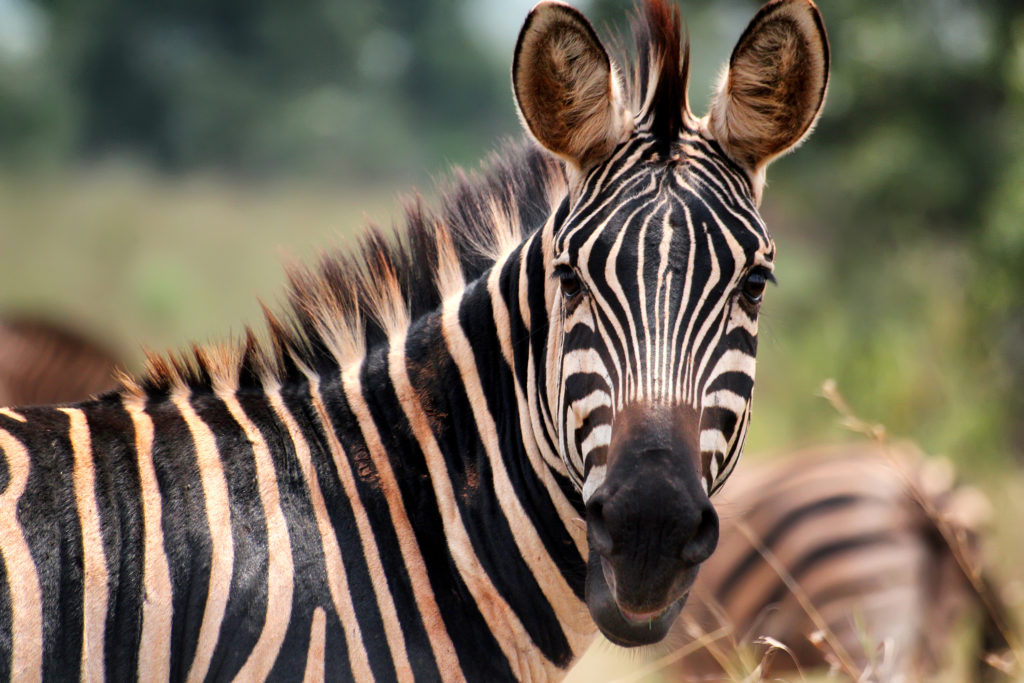
As for the coveted Big Five, buffalo are plentiful and easily seen, elephants are quite common but more difficult to track down, and leopards are present but secretive as ever. For the best part of two decades, lion sightings here had been little more than the stuff of rumour, but with the June 2015 reintroduction of seven lions (two males and five females) flown in from reserves in South Africa, Akagera is once again home to the most charismatic member of the quintet. Two more males were brought in in 2017, and signs indicate that they’re all settling in nicely – nearly a dozen cubs have been born here since the reintroductions began. The last black rhino was seen in 2007, but in May 2017 two planeloads of rhinos – 18 in all – arrived in the park and they’ve since had a calf here as well. All in all, it’s been a magnificent few years for Akagera National Park, and all signs point to more exciting times ahead.
Volcanoes National Park
The 160km² Volcanoes National Park protects the Rwandan sector of the Virunga Mountains, a range of six extinct and three active volcanoes that straddle the Ugandan and Congolese borders and protect more than half the global population of the charismatic mountain gorilla. Occasionally referred to by its French name Parc des Volcans, it forms part of a contiguous 433km² transfrontier conservation unit that protects the upper slopes of the Virungas in their entirety, and also incorporates the southern portion of the Congolese Virunga National Park and Uganda’s Mgahinga National Park. The three national parks function separately today, but prior to 1960 the Rwandan and Congolese sectors were jointly managed as the Albert National Park.
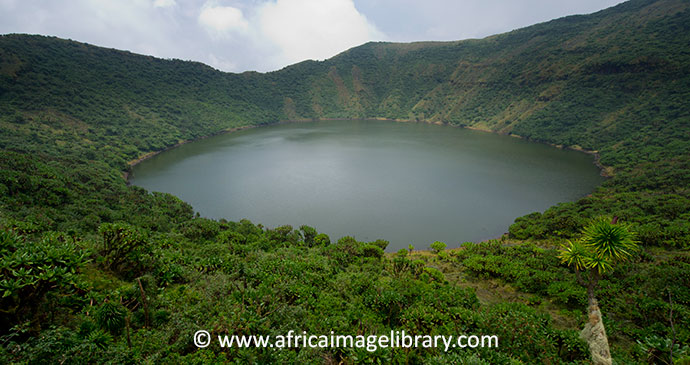
Volcanoes National Park is an immensely scenic and ecologically diverse destination. Indeed, this chain of steep free-standing mountains, spanning altitudes of 2,400m to 4,507m, and linked by fertile saddles formed by solidified lava flows, ranks among the most stirring and memorable of African landscapes. The tallest member of the chain, and the most westerly part of the national park, is Karisimbi (4,507m) on the border with the DRC. Moving eastwards, the other main peaks within the national park are Bisoke (aka Visoke) on the DRC border. Sabyinyo at the tripartite border with Uganda and the DRC, and Gahinga (aka Mgahinga) and Muhabura (aka Muhavura) on the Uganda border.
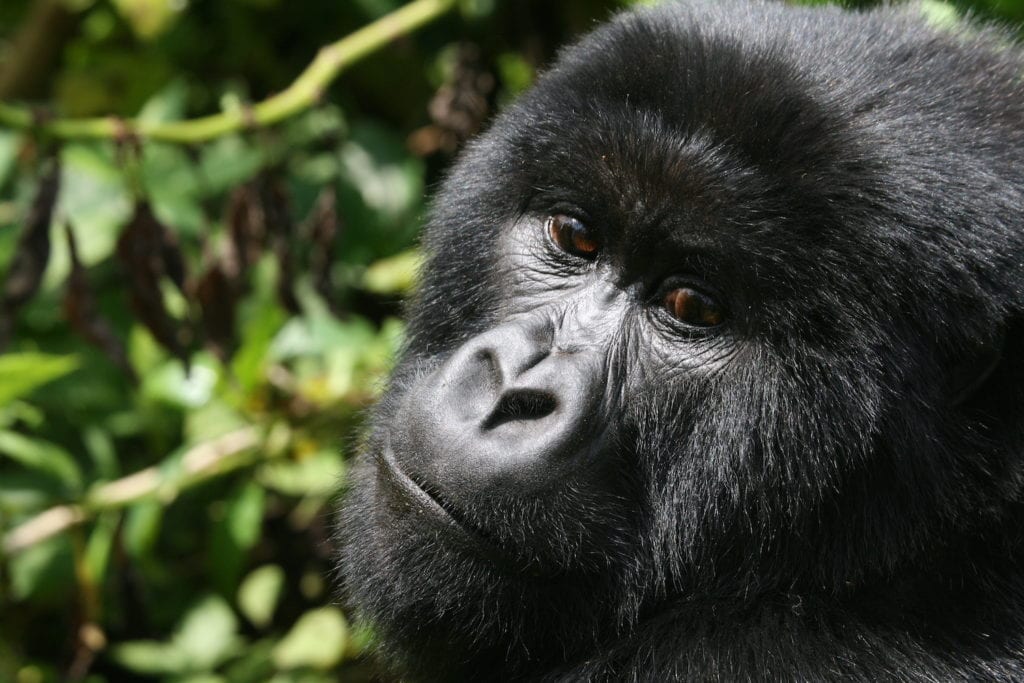
Tracking mountain gorillas is easily the most popular tourist activity in Volcanoes National Park. However, a wide variety of other hikes and activities are offered, making it possible to spend several days in the area without running out of things to do. The most popular activity after gorilla tracking is a visit to a habituated troop of the rare golden monkey, an Albertine Rift endemic whose modern range is more-or-less restricted to the Virungas. Also quite popular is the hike to Dian Fossey’s former camp and grave on the forested slopes of Karisoke. Fewer visitors embark on the more demanding day treks to the summits of Bisoke (famed for its beautiful crater lake) or Muhabura, and fewer still are up for the overnight hike to the highest point in the range, the summit of Karisimbi.
Rukari Palace Museum
The Rukari Palace Museum is the top touristic reason for visiting Nyanza; it ’s situated on a hilltop about 2km southwest of the centre, and signposted. The traditional ancient palace of the Mwami has been reconstructed, together with some other buildings, 3–4km away from its original site, beside the newer Western-style palace built for Mwami Rudahigwa Mutara III in 1932.
In olden times, Nyanza was the heart of Rwanda and seat of its monarchy, background to the oral tradition of battles and conquests, power struggles and royal intrigues. It is where the German colonisers came, at the end of the 19th century, to visit the Mwami – and contemporary reports tell of the great pomp and ceremony these visits occasioned, as well as the impressive size of the Mwami’s court.
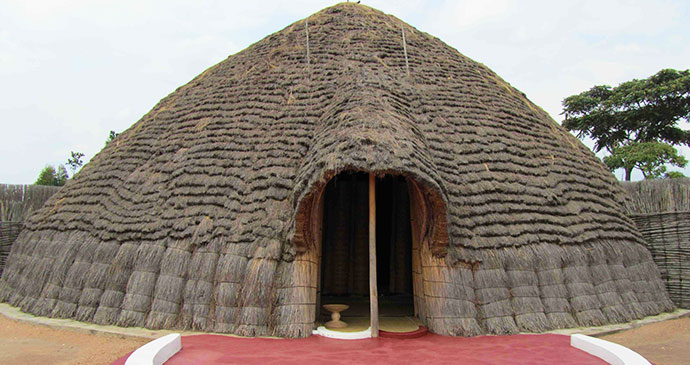
The traditional palace has been carefully reconstructed and maintained, and contains the king’s massive bed as well as various utensils. English- and French-speaking guides are available to relate the history and traditions of the royal court – there is even significance attached to some of the poles supporting the roof; for example, the one at the entrance to the king’s bed is named ‘do not speak of what happens here’ and another conferred sanctuary on anyone touching it.
The newer palace is a typical colonial-era building with its spacious rooms and wide balcony. The Travellers’ Guide above also states: ‘In certain circumstances, and with the permission of the local authorities, he [the Mwami] may be visited at his palace which is built on modern lines, furnished in good taste and richly decorated with trophies in an oriental manner.’
In more recent times, the rundown palace served for several years as the part-time home of Rwanda’s National Ballet (the Intore dancers). Now fully restored, it reopened in May 2008 as a museum whose exhibits relate to the two rulers who lived here during the early to mid 20th century, as well as the more ancient history of the Rwanda Empire. Several original items of royal furniture decorate the interior, and the walls are adorned with monochrome photographs. Other displays depict the palace when it was in use, and chart the history of Rwanda from the 5th century onwards. They’ve also introduced several long-horned Inyambo cattle to the complex and opened the burial site of Mutara III and his wife Queen Rosalie Gicanda (signposted less than 1km away).
Nyungwe Forest National Park
The largest remaining tract of montane rainforest in eastern Africa, Nyungwe extends for 1,015km² over the mountainous southwest of Rwanda, forming a contiguous forest block with Burundi’s 400km² Kibira National Park. The park is the most important catchment area in Rwanda, supplying water to 70% of the country, and its central ridge divides Africa’s two largest drainage systems, the Nile and the Congo – indeed, a spring on the slopes of the 2,950m Mount Bigugu is now regarded to be the most remote source of the world’s longest river.
As with other forests along the Albertine Rift (the part of the Rift Valley that follows the Congolese border with Uganda, Rwanda, Burundi and northwest Tanzania), Nyungwe is a remarkably rich centre of biodiversity. More than 1,050 plant species have been recorded, including 200 orchids and 250 Albertine Rift Endemics (AREs), along with at least 120 butterfly species. The vertebrate fauna includes 85 mammal, 310 bird, 32 amphibian and 38 reptile species, of which about 15% are AREs.
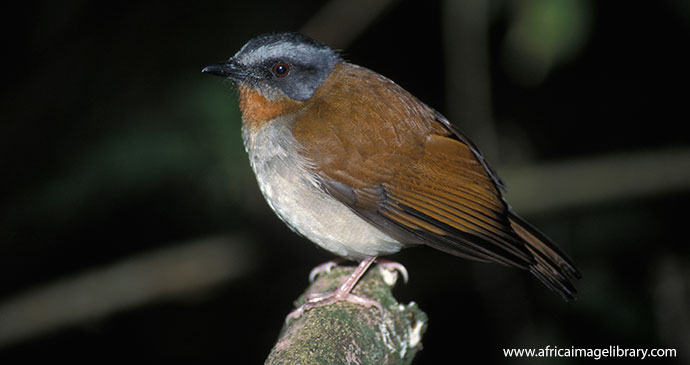
Statistics aside, Nyungwe is simply magnificent. The forest takes on a liberatingly primal presence even before you enter it. One moment the road is winding through a characteristic rural Rwandan landscape of rolling tea plantations and artificially terraced hills, the next a dense tangle of trees rises imperiously from the fringing cultivation.
For a full 50km, the road clings improbably to steep forested slopes, offering grandstand views over densely swathed hills that tumble like monstrous green waves towards the distant Burundi border. One normally thinks of the rainforest as an intimate and confining environment, and Nyungwe’s dank interior certainly possesses those qualities. But as viewed from the main road, Nyungwe is also a gloriously expansive sight.
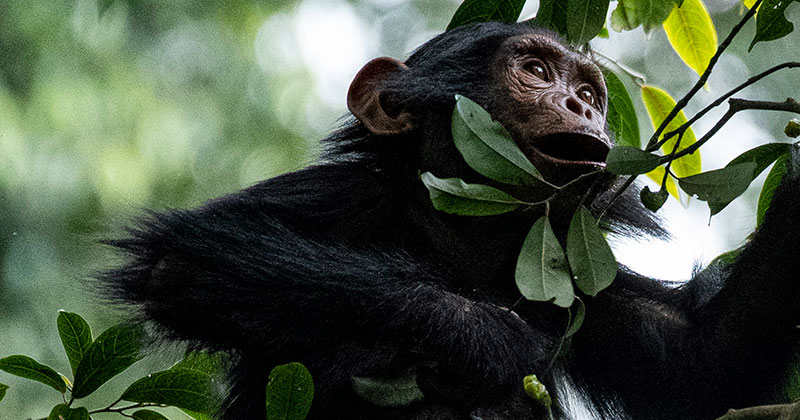
For most visitors, primates are the main attraction. All 13 species are represented, including a chimpanzee population estimated at around 500, which can usually be tracked at short notice, but several other monkeys are readily seen, including the acrobatic Ruwenzori colobus, and the localised L’Hoest’s monkey. Nyungwe is also highly alluring to birders, botanists and keen walkers, with its 130km network of walking trails, and is it is the site of the region’s only suspended canopy walk.
Related books
For more information, see our guide to Rwanda:
Related articles
From boiling lakes to vast alpine bodies of water, these are our favourite lakes from around the world.
Our pick of the best national parks to visit in Tanzania, Kenya, Uganda and Rwanda.
Get to know Rwanda before you travel there.
We’ve scoured the African continent for some of the best sites to get up close and personal with lions.
Discover Rwanda’s best kept travel secrets, from hiking Mount Bisoke to watching the stunning Intore dance performances.
Rwanda’s Maraba Bourbon coffee is one of the country’s success stories.
Janice Booth recounts her version of this ancient tale.
